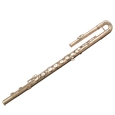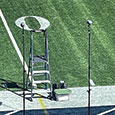The size, curve, and weight of the bass flute present special challenges for flute players. The following tips will help flutists get started with the instrument, including how to adjust the curve, tune, avoid arm fatigue, and keep the instrument stable during performances. With so many new basses and products coming on the market, there have never been so many choices and helpful tools.
Set the Curve
The first step is to learn how to adjust the curve of the instrument so it is comfortable to hold. Begin with the head joint lined up directly over the keys as shown below.
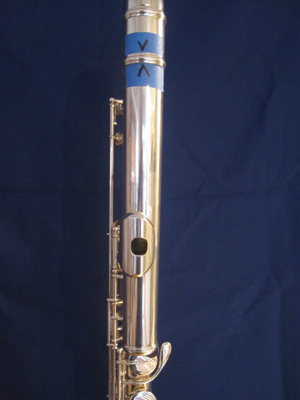
The strips of blue tape mark reference points where the headjoint goes into the curve. You will make two adjustments, one where the curve goes into the body of the flute and one where the headjoint goes into the curve. (The second set of blue tape strips is not visible because they are directly behind the headjoint.)
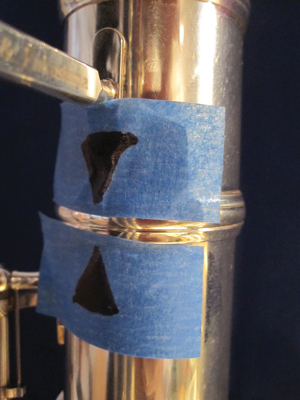
With the headjoint lined up over the keys, the picture above shows the starting position of the curve where it goes into the body. This is the second set of tape and marks not visible in the first picture.
The first adjustment to make is to rotate the curve in towards you at the point where it goes into the body. The next picture shows the new position. I rotate the curve 9/16ths of an inch – about the width of your index finger.
.jpg)
The second adjustment rotates the headjoint. Without moving the curved section, rotate the headjoint away from you about 5/16ths of an inch – about the width of the fingernail on your little finger.
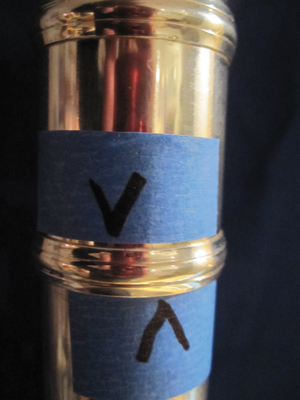
The following picture shows the results of both rotations.
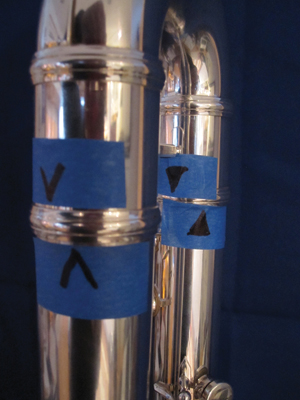
With the headjoint now in position, put the bass against your chin as if you were going to play. Check to see if you can lift all fingers away from the flute and have the flute remain stable. To play the flute well, the fingers and thumbs should only be used for closing and opening the keys, not for keeping the flute stable. If the flute wants to roll away from you, increase the distance (perhaps 11/16ths) that you move the curved part where it goes into the body. If the flute wants to fall down your chin, decrease the amount you move the curved section, maybe to 7/16ths. It will take some trial and error to find the best position. I have made a YouTube video that shows this whole process at www.youtube.com/watch?v=yy-W6R7Xhjw
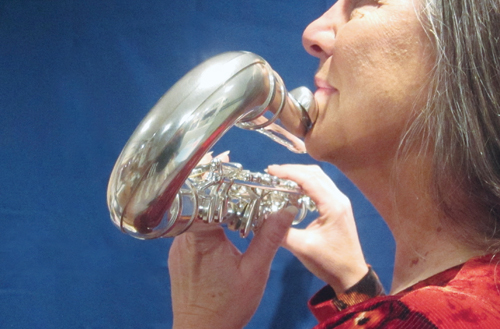
Notice the angle of the curve in relationship to the rest of the flute. The goal is to adjust the curve and the headjoint so the flute balances easily and the fingers are free to move.
The Left Hand Crutch
Many basses come with a left hand crutch that helps stabilize the instrument. The crutch is a mixed blessing as many do not fit all hand sizes. Manufacturers are beginning to offer crutches of different sizes and shapes. Other basses are designed to be played without crutches.
Tuning
To tune the instrument, play A5. This is preferable to tuning the A6 because bass flute parts are usually written in the lower octave, and the lowest is the least adjustable octave as far as the lips and alternate fingerings are concerned. Also, determine what key you are in and use the first note of that scale as a second pitch check. The pitch of the first note of the scale is just as important as the tuning A.
Pull out where the head joint goes into the curve. Usually, an instrument is pulled out about the width of the little finger for the standard tuning of A-440. I have found this preferable to pulling out where the curve goes into the body. Adjusting where the curve goes into the body actually moves your arms slightly farther away from the torso and will affect the intonation in the third octave. You can pull out a little at both locations, but the intonation is no better than just pulling out the headjoint. Why make two adjustments when you only need to make one?
Right Arm Fatigue
Many flutists experience pain in the right arm from holding the heavy flute up during rehearsals. There are several new products on the market that assist the player in holding the flute in playing position. (See my YouTube video for an example.) You can also use a solid black music stand. Flip the music rack part of a stand upside down so the place where the music usually sits is on the top. Place a thick cloth or towel on the stand and rest the end of the flute on the cloth. The support is not very flexible, but it does help. It can adjust to a standing height as well as sitting. This setup unfortunately does not look good in a performance situation, but it is primarily in rehearsals that the arm becomes so fatigued.
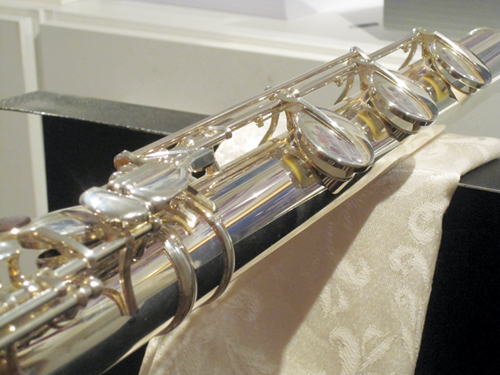
Tight Tenons
Frequently the connection between the curve and flute body is tight and difficult to adjust. Get an alcohol swab, or put rubbing alcohol on some facial tissue, and wipe both parts of the connection thoroughly. The alcohol removes any dirt or oily residue that might have collected and should solve the problem. Keep the alcohol away from the pads as it will dry them out.
If the connection is still a little tight, rub some pencil lead on the connection. Pencils use graphite, a dry lubricant used on sticky locks. The graphite will add some sliding capabilities. If it is still too tight, find a repairperson who can squeeze the tenon down a little. You may have to send the flute back to the factory to get this accomplished.
Slippery Flute
Because the bass flute is so heavy and the tube so wide, the bass seems especially vulnerable to slipping with perspiration during a performance. There are several products on the market that may be used on the embouchure plate or on the body to minimize slipping. Another option is a postage stamp cut to a half-moon shape and placed on the backside of the embouchure plate (the side that is in the chin).

With the increasing popularity of flute choirs throughout the United States, more and more flutists are purchasing and performing on the big flutes. While there are many similarities to playing the C flute, the size and weight of alto and bass flutes require flutists to experiment with the physical aspects of aligning and balancing the instrument in the hands. These tips offer a starting place, but because everyone is a different size, the best solution will be what you discover for yourself.
